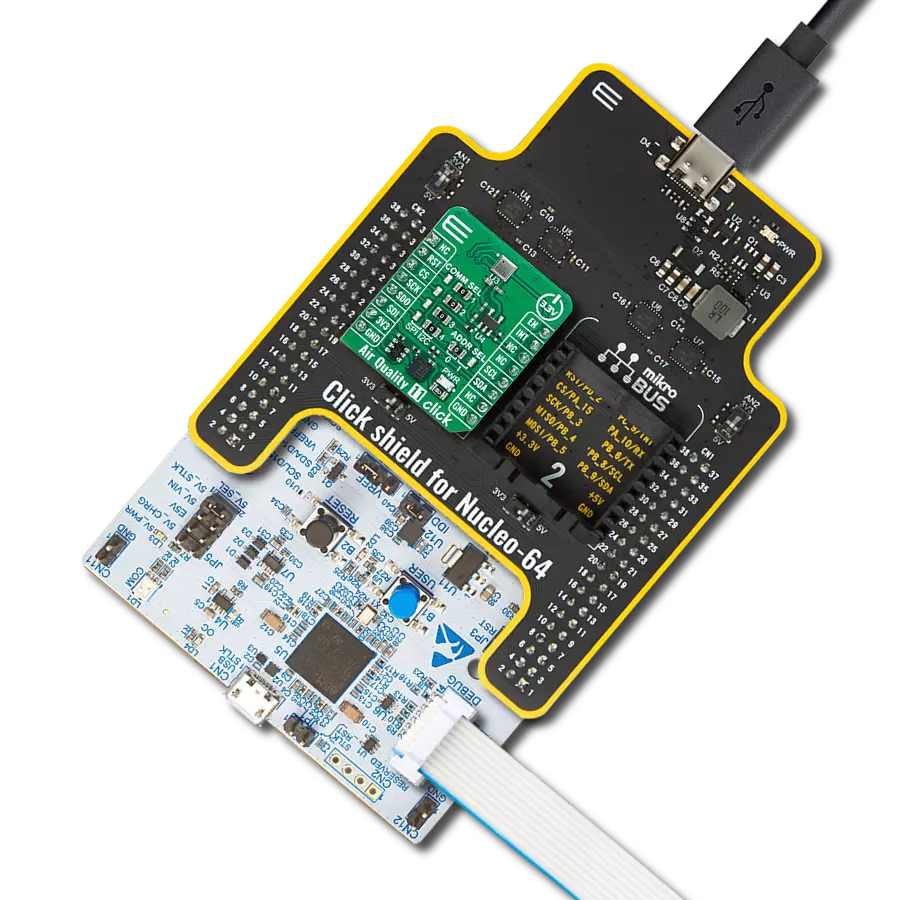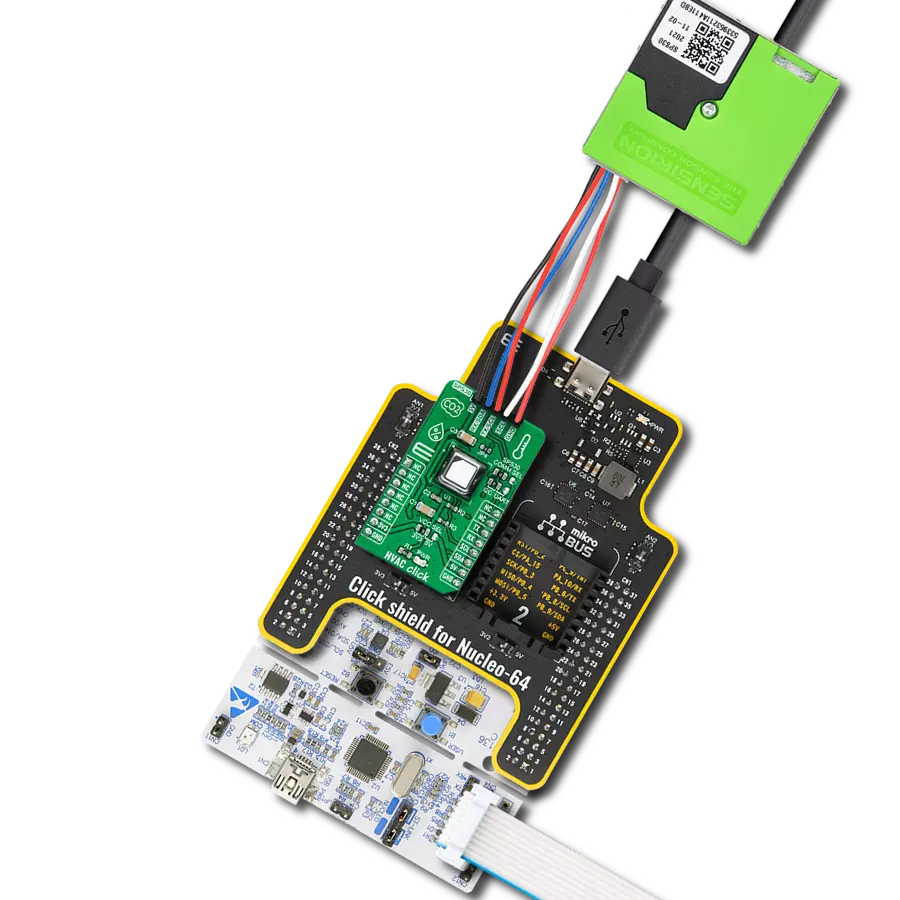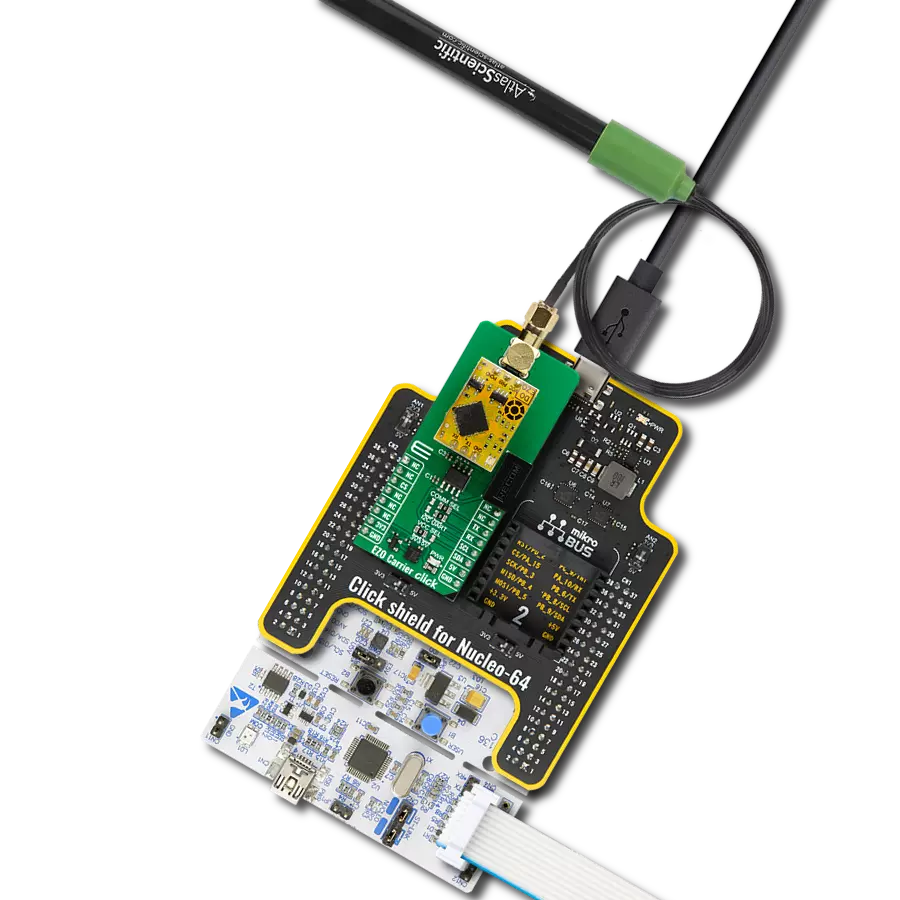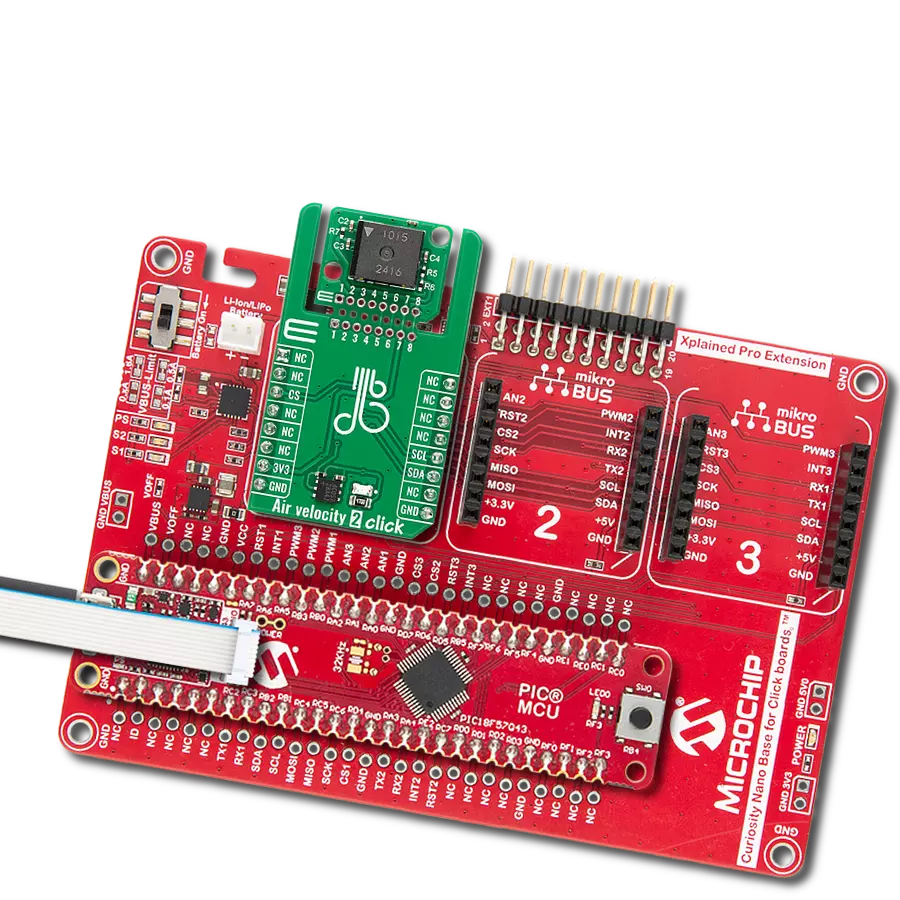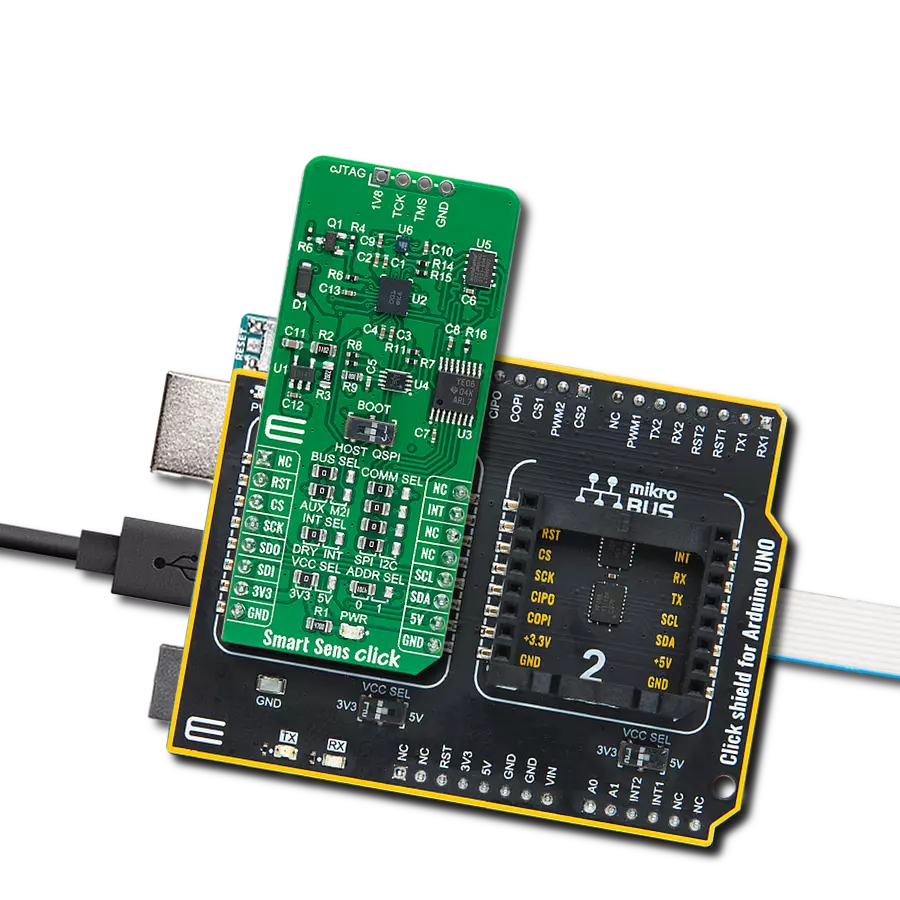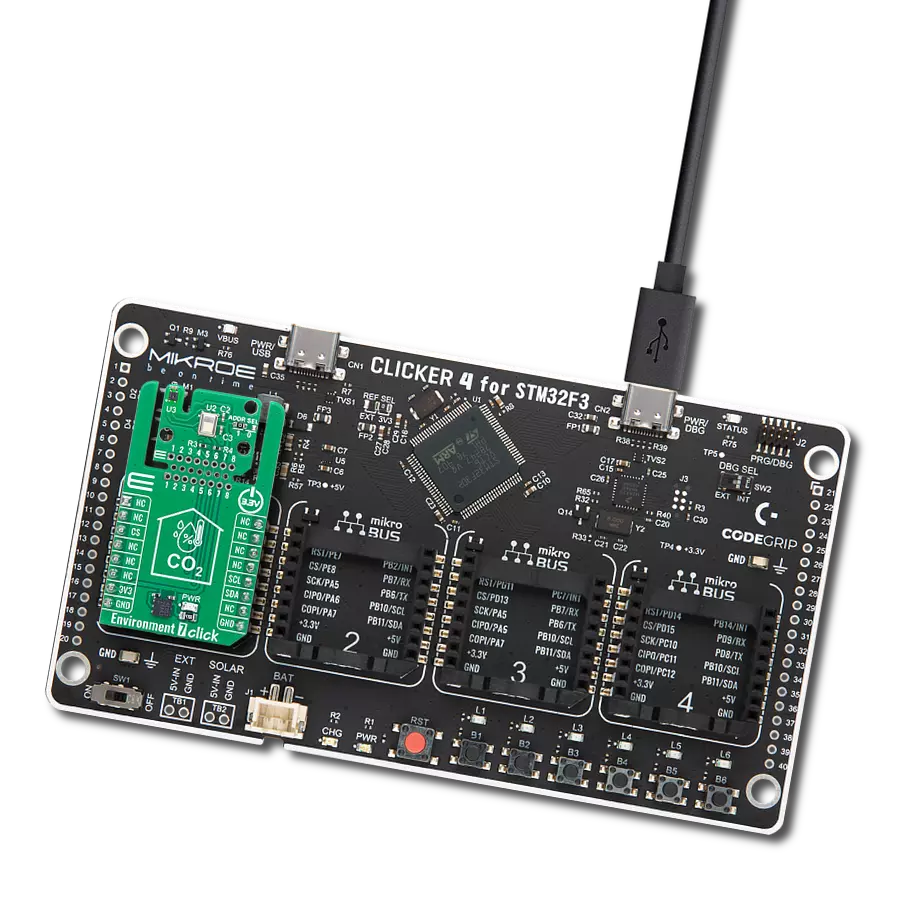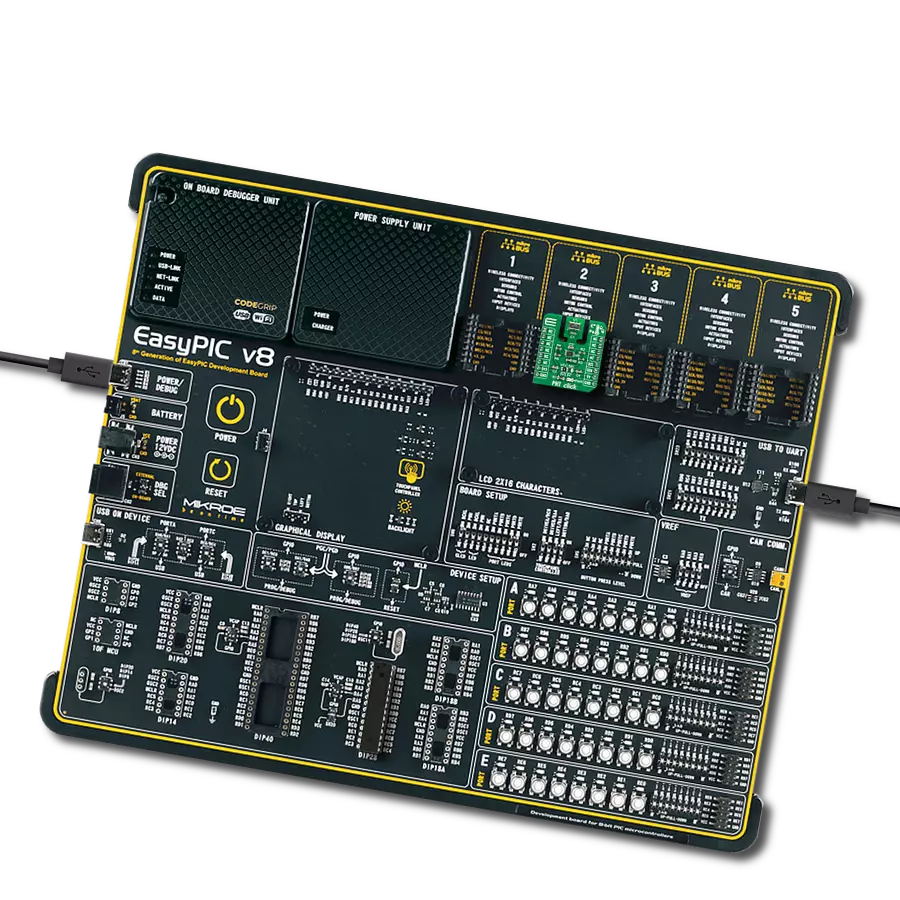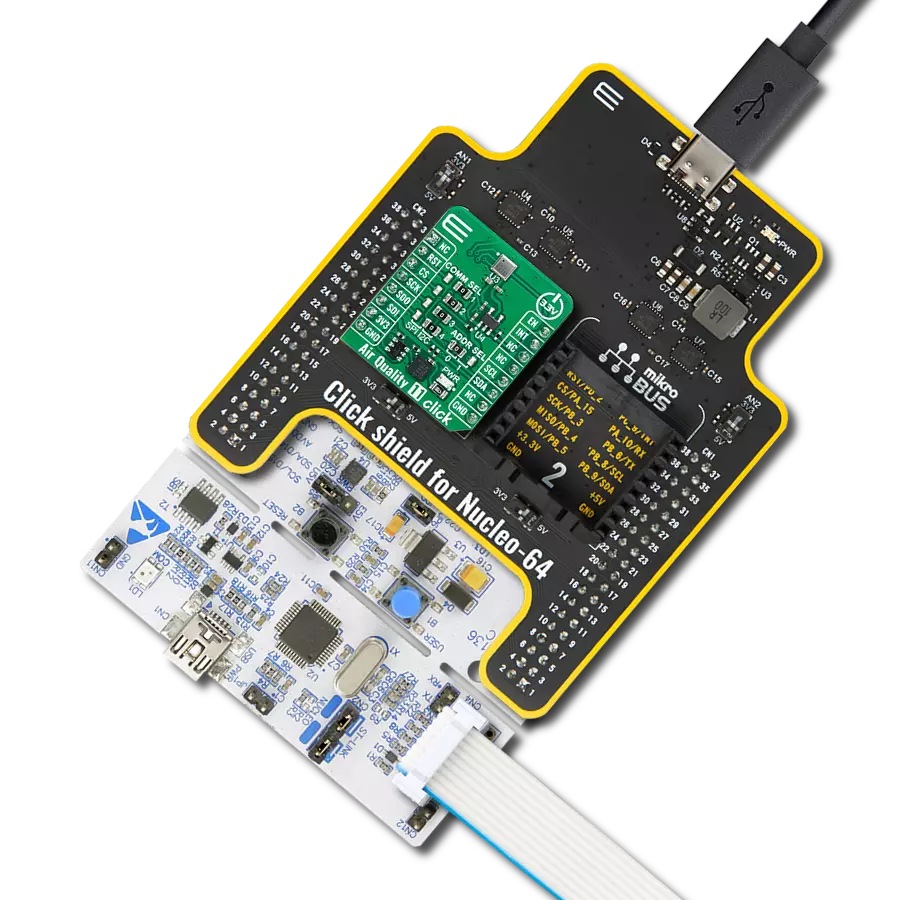Monitor and analyze the air you breathe indoors by detecting a wide range of volatile organic compounds (VOCs).
A
A
Hardware Overview
How does it work?
Air Quality 11 Click is based on the ENS161, a multi-gas sensor from ScioSense based on metal oxide (MOX) technology. It features four sensor elements that support both isothermal and low-power modes. This advanced sensor offers a unique capability of independently controlling the hotplate to detect a wide range of volatile organic compounds (VOCs) like ethanol, toluene, hydrogen, and oxidizing gases with enhanced sensitivity. Equipped with intelligent on-chip algorithms, the ENS161 processes raw sensor data to calculate various air quality metrics, such as TVOC- and CO2-equivalents and different air quality indices, and performs compensations for humidity and temperature. A key feature of the ENS161 is its TrueVOC® air quality detection, which adheres to global Indoor Air Quality (IAQ) standards. It measures equivalent CO2 (eCO2) from 0 to 65,000 ppb, meeting HVAC requirements,
and equivalent Total Volatile Organic Compounds (eTVOC) ranging from 400 to 65,000 ppm CO2-equivalent. Additionally, it supports both the German Federal Environmental Agency's (UBA) Air Quality Index (AQI-U) from 1 to 5 and a relative Air Quality Index (AQI-S) from 0 to 500. This solution finds applications in IoT devices, wearables, energy-sensitive building automation, HVAC systems, home appliances, and more. This Click board™ allows for flexible communication options, supporting both I2C and SPI interfaces. These interfaces enable communication speeds up to 1MHz for I2C and 10MHz for SPI. Users can select their preferred communication protocol by adjusting the SMD jumpers in the COMM SEL section. The jumpers must be aligned on the same side to avoid potential issues. An additional SMD jumper, labeled ADDR SEL, enables the adjustment of the I2C slave address. The ENS161 sensor operates using
a 3.3V supply from the mikroBUS™ socket for its logic-level side and uses a 1.8V as a main power supply, which is converted from the 3.3V mikroBUS™ power rail through an AP2112 CMOS LDO regulator. This LDO is enabled via the EN pin from the mikroBUS™ socket, which can also function as a global enable for the entire device. Besides the communication pins for SPI and I2C, the ENS161 also uses an interrupt (INT) pin to alert the host MCU when new output data is available. This Click board™ can be operated only with a 3.3V logic voltage level. The board must perform appropriate logic voltage level conversion before using MCUs with different logic levels. Also, it comes equipped with a library containing functions and an example code that can be used as a reference for further development.
Features overview
Development board
EasyPIC v8 is a development board specially designed for the needs of rapid development of embedded applications. It supports many high pin count 8-bit PIC microcontrollers from Microchip, regardless of their number of pins, and a broad set of unique functions, such as the first-ever embedded debugger/programmer. The development board is well organized and designed so that the end-user has all the necessary elements, such as switches, buttons, indicators, connectors, and others, in one place. Thanks to innovative manufacturing technology, EasyPIC v8 provides a fluid and immersive working experience, allowing access anywhere and under any
circumstances at any time. Each part of the EasyPIC v8 development board contains the components necessary for the most efficient operation of the same board. In addition to the advanced integrated CODEGRIP programmer/debugger module, which offers many valuable programming/debugging options and seamless integration with the Mikroe software environment, the board also includes a clean and regulated power supply module for the development board. It can use a wide range of external power sources, including a battery, an external 12V power supply, and a power source via the USB Type-C (USB-C) connector.
Communication options such as USB-UART, USB DEVICE, and CAN are also included, including the well-established mikroBUS™ standard, two display options (graphical and character-based LCD), and several different DIP sockets. These sockets cover a wide range of 8-bit PIC MCUs, from the smallest PIC MCU devices with only eight up to forty pins. EasyPIC v8 is an integral part of the Mikroe ecosystem for rapid development. Natively supported by Mikroe software tools, it covers many aspects of prototyping and development thanks to a considerable number of different Click boards™ (over a thousand boards), the number of which is growing every day.
Microcontroller Overview
MCU Card / MCU
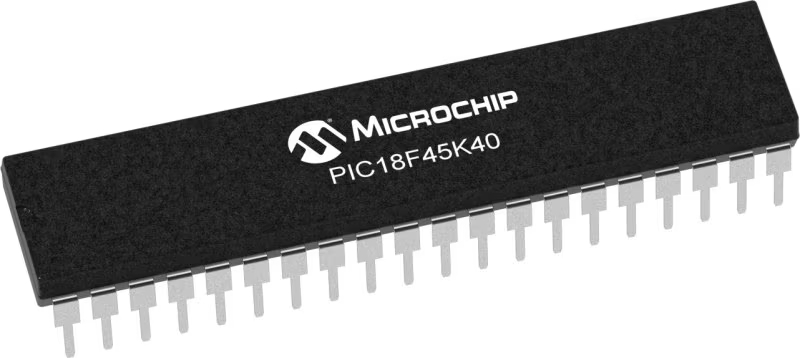
Architecture
PIC
MCU Memory (KB)
32
Silicon Vendor
Microchip
Pin count
40
RAM (Bytes)
2048
Used MCU Pins
mikroBUS™ mapper
Take a closer look
Click board™ Schematic

Step by step
Project assembly
Track your results in real time
Application Output
1. Application Output - In Debug mode, the 'Application Output' window enables real-time data monitoring, offering direct insight into execution results. Ensure proper data display by configuring the environment correctly using the provided tutorial.

2. UART Terminal - Use the UART Terminal to monitor data transmission via a USB to UART converter, allowing direct communication between the Click board™ and your development system. Configure the baud rate and other serial settings according to your project's requirements to ensure proper functionality. For step-by-step setup instructions, refer to the provided tutorial.

3. Plot Output - The Plot feature offers a powerful way to visualize real-time sensor data, enabling trend analysis, debugging, and comparison of multiple data points. To set it up correctly, follow the provided tutorial, which includes a step-by-step example of using the Plot feature to display Click board™ readings. To use the Plot feature in your code, use the function: plot(*insert_graph_name*, variable_name);. This is a general format, and it is up to the user to replace 'insert_graph_name' with the actual graph name and 'variable_name' with the parameter to be displayed.

Software Support
Library Description
This library contains API for Air Quality 11 Click driver.
Key functions:
airquality11_get_aqi_uba- This function reads the calculated Air Quality Index according to the UBA.airquality11_get_tvoc- This function reads the calculated equivalent TVOC concentration in ppb.airquality11_get_aqi_s- This function reads the calculated relative Air Quality Index proprietary to ScioSense.
Open Source
Code example
The complete application code and a ready-to-use project are available through the NECTO Studio Package Manager for direct installation in the NECTO Studio. The application code can also be found on the MIKROE GitHub account.
/*!
* @file main.c
* @brief Air Quality 11 Click example
*
* # Description
* This example demonstrates the use of the Air Quality 11 Click board
* by reading and displaying the calculated Air Quality Index according to the UBA and ScioSense,
* and equivalent TVOC and CO2 concentration.
*
* The demo application is composed of two sections :
*
* ## Application Init
* The initialization of I2C and SPI module and log UART.
* After driver initialization, the app sets the default configuration.
*
* ## Application Task
* The demo application displays the Air Quality Index of the UBA information,
* concentration of the TVOC and CO2 and Air Quality Index according to ScioSense.
* Results are being sent to the UART Terminal, where you can track their changes.
*
* ## Additional Function
* - static void airquality11_display_aqi_uba ( void )
*
* @author Nenad Filipovic
*
*/
#include "board.h"
#include "log.h"
#include "airquality11.h"
static airquality11_t airquality11;
static log_t logger;
/**
* @brief Air Quality 11 display AQI-UBA function.
* @details This function parses the Air Quality Index per UBA (AQI-UBA) value
* and displays it on the USB UART.
* @param[in] aqi_uba : AQI-UBA value.
* @return None.
* @note None.
*/
void airquality11_display_aqi_uba ( uint8_t aqi_uba );
void application_init ( void )
{
log_cfg_t log_cfg; /**< Logger config object. */
airquality11_cfg_t airquality11_cfg; /**< Click config object. */
/**
* Logger initialization.
* Default baud rate: 115200
* Default log level: LOG_LEVEL_DEBUG
* @note If USB_UART_RX and USB_UART_TX
* are defined as HAL_PIN_NC, you will
* need to define them manually for log to work.
* See @b LOG_MAP_USB_UART macro definition for detailed explanation.
*/
LOG_MAP_USB_UART( log_cfg );
log_init( &logger, &log_cfg );
log_info( &logger, " Application Init " );
// Click initialization.
airquality11_cfg_setup( &airquality11_cfg );
AIRQUALITY11_MAP_MIKROBUS( airquality11_cfg, MIKROBUS_1 );
err_t init_flag = airquality11_init( &airquality11, &airquality11_cfg );
if ( ( I2C_MASTER_ERROR == init_flag ) || ( SPI_MASTER_ERROR == init_flag ) )
{
log_error( &logger, " Communication init." );
for ( ; ; );
}
if ( AIRQUALITY11_ERROR == airquality11_default_cfg ( &airquality11 ) )
{
log_error( &logger, " Default configuration." );
for ( ; ; );
}
log_info( &logger, " Application Task " );
log_printf( &logger, "---------------------------\r\n " );
Delay_ms ( 100 );
}
void application_task ( void )
{
uint8_t aqi_uba = 0;
uint16_t aq_data = 0;
if ( AIRQUALITY11_OK == airquality11_get_aqi_uba( &airquality11, &aqi_uba ) )
{
airquality11_display_aqi_uba( aqi_uba );
Delay_ms ( 100 );
}
if ( AIRQUALITY11_OK == airquality11_get_tvoc( &airquality11, &aq_data ) )
{
log_printf( &logger, " TVOC: %u [ppb]\r\n", aq_data );
Delay_ms ( 100 );
}
if ( AIRQUALITY11_OK == airquality11_get_co2( &airquality11, &aq_data ) )
{
log_printf( &logger, " ECO2: %u [ppm]\r\n", aq_data );
Delay_ms ( 100 );
}
if ( AIRQUALITY11_OK == airquality11_get_aqi_s( &airquality11, &aq_data ) )
{
log_printf( &logger, " AQIS: %u [idx]\r\n", aq_data );
Delay_ms ( 100 );
}
log_printf( &logger, "---------------------------\r\n " );
Delay_ms ( 1000 );
}
int main ( void )
{
/* Do not remove this line or clock might not be set correctly. */
#ifdef PREINIT_SUPPORTED
preinit();
#endif
application_init( );
for ( ; ; )
{
application_task( );
}
return 0;
}
void airquality11_display_aqi_uba ( uint8_t aqi_uba )
{
switch ( aqi_uba )
{
case AIRQUALITY11_AQI_UBA_EXELLENT:
{
log_printf( &logger, " AQI-UBA Rating: Exellent\r\n" );
log_printf( &logger, " Hygienic Rating: No objections\r\n" );
log_printf( &logger, " Recommendation: Target\r\n" );
log_printf( &logger, " Exposure Limit: No limit\r\n" );
break;
}
case AIRQUALITY11_AQI_UBA_GOOD:
{
log_printf( &logger, " AQI-UBA Rating: Good\r\n" );
log_printf( &logger, " Hygienic Rating: No relevant objections\r\n" );
log_printf( &logger, " Recommendation: Sufficient ventilation\r\n" );
log_printf( &logger, " Exposure Limit: No limit\r\n" );
break;
}
case AIRQUALITY11_AQI_UBA_MODERATE:
{
log_printf( &logger, " AQI-UBA Rating: Moderate\r\n" );
log_printf( &logger, " Hygienic Rating: Some objections\r\n" );
log_printf( &logger, " Recommendation: Increased ventilation - Search for sources\r\n" );
log_printf( &logger, " Exposure Limit: < 12 months\r\n" );
break;
}
case AIRQUALITY11_AQI_UBA_POOR:
{
log_printf( &logger, " AQI-UBA Rating: Poor\r\n" );
log_printf( &logger, " Hygienic Rating: Major objections\r\n" );
log_printf( &logger, " Recommendation: Intensified ventilation - Search for sources\r\n" );
log_printf( &logger, " Exposure Limit: < 1 month\r\n" );
break;
}
case AIRQUALITY11_AQI_UBA_UNHEALTHY:
{
log_printf( &logger, " AQI-UBA Rating: Unhealthy\r\n" );
log_printf( &logger, " Hygienic Rating: Situation not acceptable\r\n" );
log_printf( &logger, " Recommendation: Use only if unavoidable - Intensified ventilation recommended \r\n" );
log_printf( &logger, " Exposure Limit: hours\r\n" );
break;
}
default:
{
log_printf( &logger, " AQI-UBA Rating: Unknown\r\n" );
break;
}
}
log_printf( &logger, "- - - - - - - - - - - - - -\r\n " );
}
// ------------------------------------------------------------------------ END


















